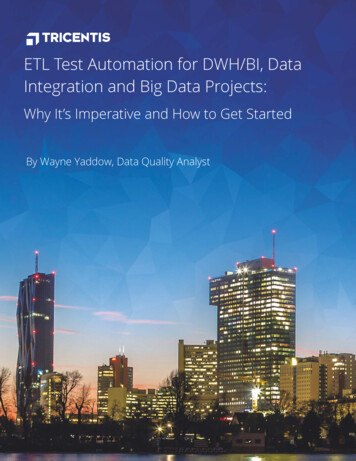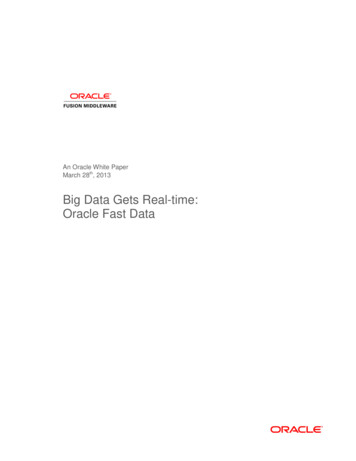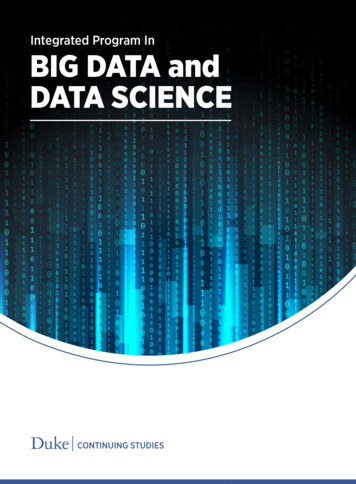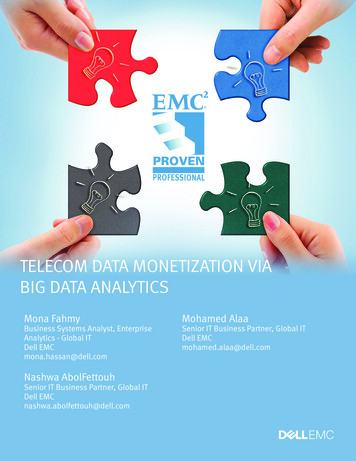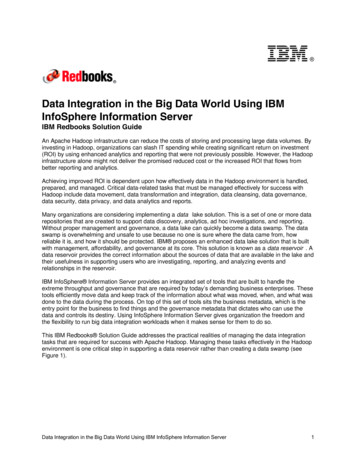
Transcription
Data Integration in the Big Data World Using IBMInfoSphere Information ServerIBM Redbooks Solution GuideAn Apache Hadoop infrastructure can reduce the costs of storing and processing large data volumes. Byinvesting in Hadoop, organizations can slash IT spending while creating significant return on investment(ROI) by using enhanced analytics and reporting that were not previously possible. However, the Hadoopinfrastructure alone might not deliver the promised reduced cost or the increased ROI that flows frombetter reporting and analytics.Achieving improved ROI is dependent upon how effectively data in the Hadoop environment is handled,prepared, and managed. Critical data-related tasks that must be managed effectively for success withHadoop include data movement, data transformation and integration, data cleansing, data governance,data security, data privacy, and data analytics and reports.Many organizations are considering implementing a data lake solution. This is a set of one or more datarepositories that are created to support data discovery, analytics, ad hoc investigations, and reporting.Without proper management and governance, a data lake can quickly become a data swamp. The dataswamp is overwhelming and unsafe to use because no one is sure where the data came from, howreliable it is, and how it should be protected. IBM proposes an enhanced data lake solution that is builtwith management, affordability, and governance at its core. This solution is known as a data reservoir . Adata reservoir provides the correct information about the sources of data that are available in the lake andtheir usefulness in supporting users who are investigating, reporting, and analyzing events andrelationships in the reservoir.IBM InfoSphere Information Server provides an integrated set of tools that are built to handle theextreme throughput and governance that are required by today’s demanding business enterprises. Thesetools efficiently move data and keep track of the information about what was moved, when, and what wasdone to the data during the process. On top of this set of tools sits the business metadata, which is theentry point for the business to find things and the governance metadata that dictates who can use thedata and controls its destiny. Using InfoSphere Information Server gives organization the freedom andthe flexibility to run big data integration workloads when it makes sense for them to do so.This IBM Redbooks Solution Guide addresses the practical realities of managing the data integrationtasks that are required for success with Apache Hadoop. Managing these tasks effectively in the Hadoopenvironment is one critical step in supporting a data reservoir rather than creating a data swamp (seeFigure 1).Data Integration in the Big Data World Using IBM InfoSphere Information Server1
Figure 1. Data reservoirs are a critical step in effective use of HadoopDid you know?In the past, there was a well-known marketing mantra called “The 3 Vs” that addressed the volume,velocity, and variety aspects of data in the new “Internet of Things” (see Figure 2).Data Integration in the Big Data World Using IBM InfoSphere Information Server2
Figure 2. The 3 Vs of volume, velocity, and varietyThen, people realized that data quality is still relevant in this new world, so many articles andpresentations introduced a fourth V, veracity . Hadoop can support all of these capabilities, but it requiresa great deal of complex programming. There have also been alternative technologies available that haveprovided these capabilities without requiring a paradigm shift. Parallel processing technology has beenavailable both inside and outside of databases for many years, and these technologies have handledterabytes of information. Handling the velocity or “data in motion” has also been available throughstreaming technology.If the 4 Vs aren’t enough alliteration, you can also consider the 3 As and the 3 Ss. In fact, seriousbusiness organizations demand all of them in data processing environments, including Hadoop. Theemergence of the 3 As of availability, accessibility, and accountability along with the 3 Ss of sovereignty(restricting data location), security, and service level agreement (SLA) for Hadoop environments ishealthy. This demand demonstrates that Hadoop is being seriously considered for critical businessworkloads. It is these attributes that are driving the governance focus and the desire to transform the dataswamp into the data reservoir.Business valueThe rapid emergence of Hadoop is revolutionizing how organizations take in, manage, transform, store,and analyze big data. Successful Hadoop projects can deliver business value and ROI through pure costreduction. Also, increased revenue and profitability can be realized from deeper analysis of large datavolumes that organizations simply could not afford to store and process in the past.Effective big data integration and governance is critical for trusted big data. Without it, you get “garbagein, garbage out.” Unless organizations address these critical areas, they produce insights ortransformative results that incomplete are significantly less accurate.Data Integration in the Big Data World Using IBM InfoSphere Information Server3
The emergence of the Hadoop infrastructure is making it possible for organizations to eliminate significantbusiness and technical limitations of data integration processes and practices. Some of these processesand practices have accumulated over years, even decades. Over time, many organizations havecontinued to rely on hand coding of data integration logic rather than using commercial data integrationsoftware. In addition, most of the commercially available extraction, transformation, and loading (ETL)tools and data integration software platforms were never built on shared nothing, massively parallelsoftware architectures. As storage costs have decreased steadily and data volumes have grown,organizations that rely on hand coding or non-scalable ETL tools have been forced to push 100% of theirbig data integration workloads into a parallel database (most often, the enterprise data warehouse).Note: This guide refers to both ELT and ETL, based on their appropriate use.Under certain conditions, running big extract, load, and transform (ELT) workloads in the paralleldatabase is appropriate. However, when an organization is forced to run 100% of big ELT workloads inthe parallel database without a distinct massively scalable data integration platform, many negative andunforeseen consequences emerge and build up over time: Data warehouse database computing and storage hardware is expensive, often costing 10X or morethan commodity Linux or Intel systems. Hand coding is 10X more costly than using data integration software for building and maintaining ETLor ELT workloads. Hand coding projects also take longer to complete (adding new data sources to awarehouse can take months rather than days or hours). Finally, reliance on hand coding makes itvery difficult, even nearly impossible, to establish data governance across the enterprise. Data integration workloads can consume a growing percentage of the database processing capacity.ELT workloads can consume 40 - 80% of the warehouse processing capacity, for example. Thismakes it difficult to meet SLAs for database queries. Rather than consuming excess warehouseprocessing capacity, ELT workloads can also influence capital investment decisions to addprocessing capacity. As data volumes increase, they add pressure on the ETL processing window. Any disruption or glitchin the process can encroach on the query processing window. That can affect throughput and wreakhavoc on SLAs. It is often not possible to run more complex data integration logic in the database, such as customername and address matching or consolidation. Consequently, data quality is often lower in theabsence of more robust data integration processing. It becomes expensive and time-consuming to add new data sources to the enterprise datawarehouse. Also, the warehouse does not grow as quickly as it is possible to do with massivelyscalable data integration software running on a commodity Linux or Intel grid.100% reliance on running big ELT workloads in the parallel database can result in tens or even hundredsof millions of dollars of negative ROI over a period of years (higher costs, longer time to value, poorquality data, limited data governance). Data integration becomes a source of competitive disadvantagerather than competitive advantage under this scenario.Historically, organizations that rely on a massively scalable data integration platform, such as the IBMInfoSphere Information Server, have not suffered the negative consequences that result from pushing100% of big ELT workloads into the parallel database. These organizations can build a data integrationjob once and process massive data volumes wherever it makes the most sense (in the ETL grid, in theparallel database, or in Hadoop). They can also implement data governance effectively across theenterprise by using IBM data governance tools.Data Integration in the Big Data World Using IBM InfoSphere Information Server4
In such a pattern, Apache Hadoop infrastructure can drastically reduce the overall costs of storing andprocessing large data volumes (including data integration processing). In addition, Hadoop provides areal opportunity to eliminate many of the significant negative consequences for organizations that run100% of their big data integration workloads in the parallel database.Solution overviewPerception is not always reality, and one size does not really fit all. The reality is that not all of anorganization’s big data integration workloads can be effectively run in the Hadoop environment.Organizations will need to continue running certain big data integration workloads outside of Hadoop. Theemerging preferred practice for big data integration and governance is to rely on a massively scalabledata integration and governance platform, such as the IBM InfoSphere Information Server. With solutionssuch as this, you can build a data integration job once and then have the freedom and flexibility to run thebig data integration workload wherever it makes the most sense (in the ETL grid, in the parallel database,or in Hadoop). You can also manage data governance across these three environments.As Figure 3 shows, each of these three environments offers advantages and disadvantages for runningbig data integration workloads. Big data integration requires a balanced approach that supports all threeenvironments.Figure 3. The advantages and disadvantages of the three environments for big data integration workloadsThe two primary components of Hadoop infrastructure include the Hadoop distributed file system forstoring large files and the Hadoop distributed parallel processing framework, known as MapReduce. Onecommon fallacy about big data integration is that you can combine any non-scalable ETL tool withMapReduce to produce a highly scalable big data integration platform. In reality, MapReduce was notdesigned for high-performance processing of massive data volumes but, instead, for finely grained faulttolerance. The IBM InfoSphere Information Server data integration platform is capable of processingtypical data integration workloads 10 to 15 times faster than MapReduce. A second shortcoming ofMapReduce for big data integration is that not all complex data integration logic can be pushed intoMapReduce. Forcing this situation makes it necessary to engage in sophisticated programmingalgorithms to handle more complex logic or to limit data integration processing to only simple logic. TheseData Integration in the Big Data World Using IBM InfoSphere Information Server5
limitations of MapReduce suggest that you need a platform such as the IBM InfoSphere InformationServer running in Hadoop without MapReduce to overcome the performance and functional limitations ofMapReduce.Solution architectureSo how do you determine whether you should run your data integration workloads in the ETL grid, in theparallel database, or in the Hadoop environment? There is no simple answer. Each environment offersadvantages and disadvantages. The following sections provide guidelines for understanding when eachenvironment is appropriate: Hardware and storage costsParallel processing software architectureDeveloper skillsHandling unstructured dataOffloading ELT from the EDW to HadoopJoins, aggregations, and sorts in HadoopHadoop and data collocationInformation governanceHardware and storage costsThe ETL grid and Hadoop environments can maximize the same commodity computing and storagecomponents, so neither environment offers any cost advantage over the other. In contrast, the paralleldatabase used for running big ETL workloads is usually the enterprise data warehouse (EDW). Big EDWenvironments usually maximize computing and storage hardware that is much more expensive (10 - 50times more) than commodity computing and storage hardware. The EDW offers a clear costdisadvantage.Parallel processing software architectureThe most scalable software architecture for processing big data integration workloads is the sharednothing, data flow architecture with data pipelining, and data partitioning across nodes. Most paralleldatabases support this software architecture and can provide highly scalable massively parallelprocessing (MPP) for data integration workloads (although there might be some performancedegradation in Hadoop environments caused by landing the data to support the fine-grained recoveryfunction). Another limitation of the parallel database is that you cannot express more complex dataintegration logic in SQL (data cleansing, for example).The InfoSphere Information Server is a scalable data integration platform built on this softwarearchitecture. It can provide highly scalable MPP processing for data integration workloads in all t
emerging preferred practice for big data integration and governance is to rely on a massively scalable data integration and governance platform, such as the IBM InfoSphere Information Server. With solutions such as this, you can build a data integration job once and then have the freedom and flexibility to run the





